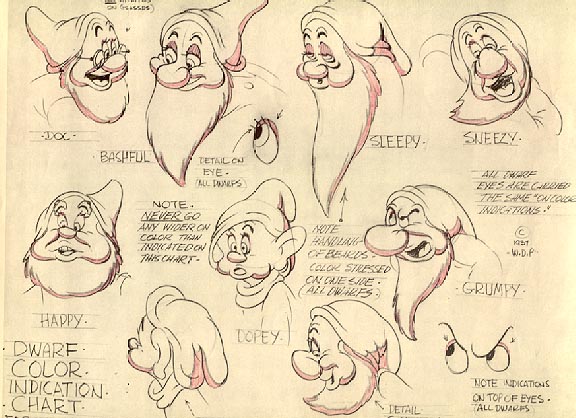Starting the Discussion
 How Money Talks in Cartoons
How Money Talks in Cartoons
Klein,
pp. 91-145
- OK, so how does
money talk in cartoons? What's the relationship between what is produced and
the funding? How does the money determine what we see?
- "It was indeed a buyer's
market on all levels [in 1936]," according to Klein. What does this mean
in practical terms?
- Also in the mid-thirties, costs
were rising as cartoons were being repackaged. What was changing? How did
this involve such things as storyboarding and pencil tests?
- Define "full animation."
- What does Klein's watercolor find
(described on p. 96-97) tell us about life at the Disney studio in this period?
How does that contrast with the recollections of Bill Melendez?
- "It is curious," Klein
notes, "that so much investment in animation resulted in a much tamer
cartoon." Then he sums up, "Corporatizing cartoons tends to remove
those elements that make the animation surprising or funny." How do these
comments echo some of the observations of Richard Schickel?
- If "media must be studied
by the evidence of how an audience remembers (entertainment, leisure, personal
details, history, politics)," then what great shift, underway in the
1930s, is still evident in our contemporary culture?
- A paradox: "Cartoons are
timeless because they look--and feel--like the year they were made."
Explain.
- In Chapter 10, Klein focuses on
three cartoons which he considers to be transitional between the anarchic,
graphically-defined world of primarily silent cartoons and the new "full
animation," particularly associated with the Disney studio. Though you're
not seeing this trio, the text gives a full description, so you should be
able to understand this shift in style from it. As you read, jot down what
makes each cartoon "transitional."
- What, according to Klein, is the
full animation alternative to graphic narrative, with its flat surfaces?
- For a story man at Disney in the
late 1930s, what did it mean to be required to take a very moralistic view
of the state of the world? What are some of the rules of screenwriting that
flow from that requirement? How do the final scenes of Snow White
serve to illustrate what this means?
- Can you see any clues in American
culture of the period to account for the shift from the swashbuckling melodrama
of the early 1930s to the more family-centered melodrama of the mid to late
decade?
- How is the directive to "Work
hard, stay pure, show some mechanical ingenuity, but still know your place;
then the cosmic Fates of capitalist justice will help you rise" related
to the melodramatic concept of "poetic justice"?
- How do "cautionary cartoons,"
such as the Fleischer's Cobweb Hotel, fit into this scheme of things?
- How does Klein see Popeye as prediction
of things to come, particularly in the Warner Brothers' cartoons of the 1940s?
- Just to check your reading, how
many cells were actually produced for Snow White? How many made it
into the finished product?
- Klein sees the scene with Snow
White in the forest as "one of the last times Disney used thirties metamorphosis
and animism," yet it is also a prime example of the new style of full
animation. How does this work?
- How does the phrase, "she
was born to clean," point to one of the shifts between an old model of
female perfection (Betty Boop) and the new, post-depression one? How could
we see Snow White's personality as in some sense standing in for "the
cult of childhood innocence in the late thirties"?
- In Snow White, Klein
sees three conflicting media fighting for the same space at the same time;
what are they?
- The chapter concludes: "Disney
with Snow White began the process that eventually mixes consumer
memory with urban planning. He pioneered the complete intersection between
electronic media and architectural space that we all know very well today."
Explain.

Back
to Home Page
 How Money Talks in Cartoons
How Money Talks in Cartoons  How Money Talks in Cartoons
How Money Talks in Cartoons 